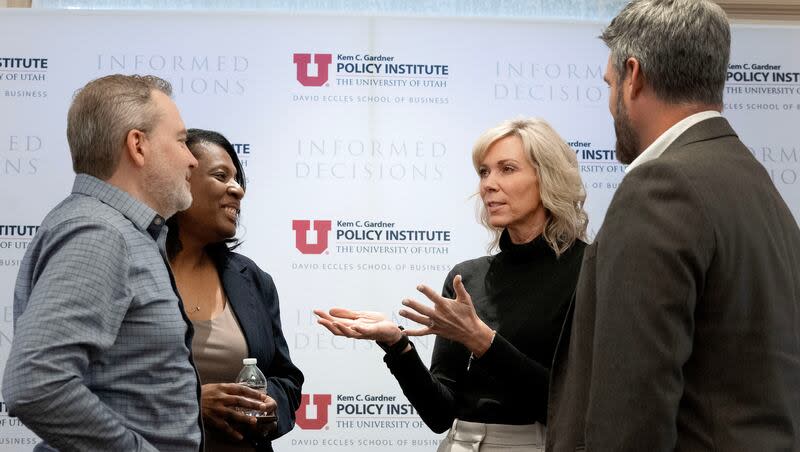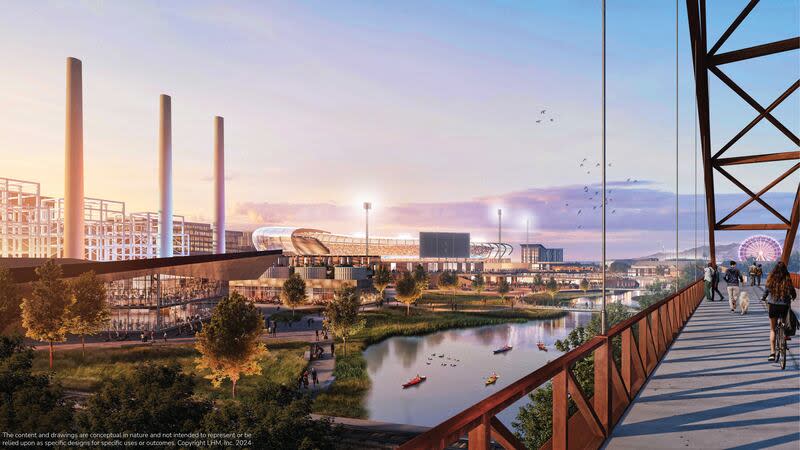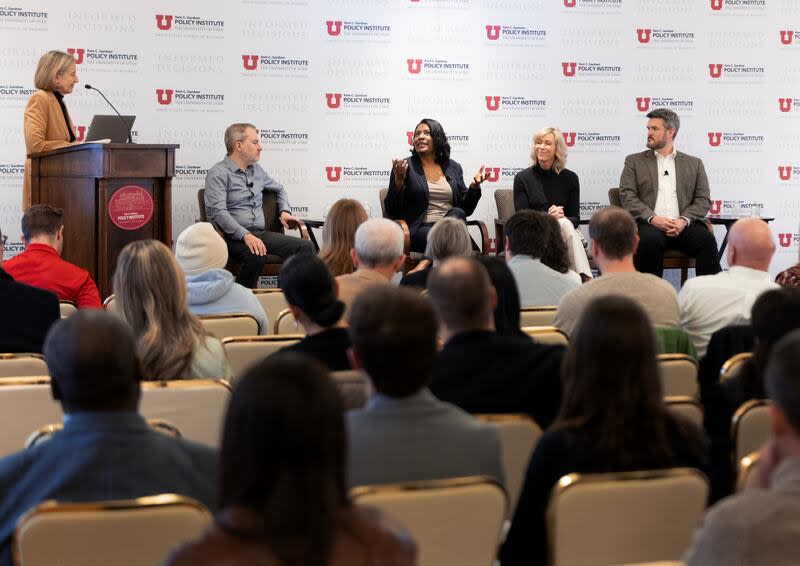If they come, we will build it: Lawmakers back MLB, NHL pursuits with nearly $2B. Now what happens?

- Oops!Something went wrong.Please try again later.
- Oops!Something went wrong.Please try again later.
“Catalyst,” “revitalization” and “reimagination” were terms visited repeatedly by speakers at a Wednesday panel discussion exploring what comes next, and why it matters, for dual pursuits to bring new Major League Baseball and National Hockey League franchises to Salt Lake City.
The conversation comes on the heels of a just-completed 2024 Utah legislative session that saw a pair of bills earn overwhelming support to back both potential projects with tax increment financing options that set the groundwork for public-private partnerships to tackle the multibillion-dollar endeavors.
It’s worth it for a lot of reasons, supporters say, but one of the foremost is the critical need for new investment in both Salt Lake City’s west side community and downtown core, the proposed sites for, respectively, a new baseball park and NHL arena.
A potential new major league ballpark would be part of a $3.5 billion mixed-use development the Larry H. Miller Company is planning on Salt Lake City’s long-neglected west side, which includes cleaning up the Jordan River and improvements to the Utah State Fairpark. The company said it intends to build out the area with or without a baseball stadium.
HB562 created the Utah Fairpark Area Investment and Restoration District, covering the area north of I-80 between 1000 West and Redwood Road. A five-member board, including a west side resident, will determine land use, recruit businesses, contract for public safety services, and leverage growth in tax increment and sales within the area to pay for the improvements inside the district.
The stadium would be funded with private dollars, state sales tax revenue and rental car taxes, paid for primarily by out-of-state visitors. The district would have the ability to raise the car rental 1.5% for construction of a baseball stadium only if MLB awards Utah a franchise, with a 2032 deadline for that to happen. The law approves bonding for half the cost of a stadium up to $900 million. The state would own the ballpark and lease it back to a team for $150,000 a month for 30 years. If a team leaves the city before that time, it would have to repay the taxpayer-generated funds.
The NHL-focused bill, SB272, creates the option for a .5% sales tax increase in Salt Lake City and allows for bonding so the increased tax money could go to fund a new NHL arena, renovate the Delta Center, or both, as well as infrastructure investments for a yet-to-be-determined area that the city designates. An earlier version of the bill allowed up to $900 million in additional tax revenue for construction of an arena, but that figure was removed in final legislation. A maximum dollar amount would be stated in the participation agreement. The law requires a team to pay back any tax money it receives if it leaves before 30 years.
At Wednesday’s sports stadium forum, hosted by the University of Utah’s Kem C. Gardner Policy Institute, Gardner director and associate dean for the U.’s David Eccles School of Business, Natalie Gochnour, noted Salt Lake City’s critical role in the state’s overall economic well-being.
“Salt Lake City serves as the foremost and flourishing center for commerce, sports, entertainment, culture and education in the Intermountain West,” Gochnour said. “In the next decade, Salt Lake City will continue to build its economic footprint. Central to this endeavor is the critical importance to the state’s economy of a strong urban core.”
Gochnour said Salt Lake City has bucked the trend of urban outmigration in recent decades, showing a higher growth rate than many cities across the country and outpacing other Utah urban centers. She pointed to a series of major investments that have helped fuel — and maintain — the city’s economic vitality, including Delta Center, TRAX light rail, City Creek Center, Eccles Performing Arts Center, Hyatt Regency convention hotel and others.
Will new homes for Utah NHL and MLB teams become the next items on that list?
The cost of building professional sports venues has skyrocketed in the past few decades and mechanisms behind funding the projects have made some version of public/private partnerships an essential economic element. To that end, both efforts have checked the box on securing taxpayer backing, although both groups say that calling the use of public funds an “investment” is more accurate than “subsidy.”
The rationale to support that phrasing, according to LHM and the Smith Entertainment Group, the sports and entertainment firm operated by Ryan and Ashley Smith that owns the Utah Jazz and other holdings, is that both groups envision projects in which their proposed sports venues are elements in bigger revitalization efforts aiming to transform their host communities.
And Gardner panelist Sen. Lincoln Fillmore, R-South Jordan, agrees.
“These are both going to be good investments for the state of Utah and I think they’ll pay off for generations,” Fillmore said. “Thirty years from now … panelists here will say ‘I am so grateful that the state had the foresight to partner with these private investors.’”
Fillmore said the combined efforts could draw as much as $10 billion in private investment into their host communities.
SEG representative Mike Maughan said any public funds going to help support a downtown revitalization would be considered a “very sacred thing.”
“We wouldn’t take any of that if we didn’t believe the investment would pay massive dividends,” Maughan said. “That’s what this is all about. Why it has to be such a catalyzing moment for downtown. We only get these opportunities once in a generation or two.”
Amanda Covington, LHM’s chief corporate affairs officer, noted the improvements that would accompany the expansive plans that are coming for the west side’s Power District project include new affordable housing options, open space, Jordan River restoration work, new commercial ventures and new jobs.

In addition to drawing new companies to Utah, Covington said the Power District project will fuel opportunities that simply don’t exist right now “when we start to hire west side residents to be accountants for the team, work on engineering, construction ... or being vendors.”
West side legislator and Minority Party Assistant Whip Rep. Sandra Hollins, D-Salt Lake City, said investment that leads to new jobs and business opportunities in her district is long overdue.
“My community is moderate- to lower-income people ... and a lot of people who work two or three jobs to make ends meet,” Hollins said. “This is needed. That human capital and excitement it brings.”
Neither of the newly minted tax increment plans move forward without the actual securing of NHL and/or MLB franchise agreements. And while LHM says its project happens either way, there isn’t a clear alternative to a downtown revitalization plan if the NHL deal doesn’t come to fruition, but Maughan noted that “the Jazz already exist so the investment needs to happen whether we have hockey or not.”
Both LHM and SEG report their pro sports efforts continue to move forward and include ongoing and positive communications with their respective league officials. While MLB looks like it is probably a year or two away from making an official move on league expansion, Utah fans could get a taste of top-tier baseball if the Oakland A’s decide to play here while their new Las Vegas stadium gets built. SEG has a couple of pathways to an NHL team that include league officials granting their formal expansion request, submitted last month, or via acquisition, with the troubled Phoenix Coyotes the most likely target.


